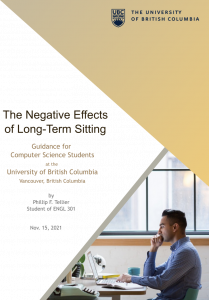The second unit of ENGL 301 involved a mix of different writing assignments. We needed to write a list of the best networking practices for LinkedIn, begin planning out a formal report on a topic of our choosing, and create a proposal for this report. Students also peer reviewed each others formal report proposals within writing teams of four. The LinkedIn assignment was designed to hone our networking expertise by researching LinkedIn best practices. On the other hand, the formal report proposal and associated peer reviewing taught organizational skills for writing. It gave insight into how a professional technical writer would make preparations within their organization to write a great report.
While I can see how writing a guide on LinkedIn networking could help some students learn online networking practices, I learned little. As a second-degree student with work experience in a competitive field, I already knew how to use LinkedIn well. Furthermore, I am hesitant to say that any list of best practices can be known as the most effective way to navigate the professional environment. It might stem from a skepticism of the social sciences, but in my opinion the scenarios and goals of people using LinkedIn vary too much for conclusions to be drawn from anecdotes and controlled studies. Best practices depend on what the individual wants to achieve and who they want to appeal to. In essence, I believe each person should act on LinkedIn according to their particular situation, and not strictly adhere to a generalized list.
Most students would agree that a formal report with a minimum of 12 pages is daunting, especially for students in programs that do less writing like myself. Although I conform to this, the requirement for both a formal report outline and a report proposal helped. This required us to get organized by breaking down the task into more manageable pieces. Specifically, we created a schedule of the sub-tasks to complete in the proposal. In this way, we committed to avoiding procrastination and we re-imagined the workload as reasonable. It was difficult for me to decide on the topic of my report, the negative effects of long-term sitting, but once I did it was fairly easy to find subtopics and design an outline.
The peer review I received for my formal report proposal was mostly positive which was reassuring. There were nuanced parts of my proposal that I could have been clearer about since my reviewer did not understand them. For instance, I could have expanded on what is currently known about the long-term effects of sitting, and what I think students know. When peer reviewing my writing teammate’s formal report proposal, I put into practice phrasing my critiques as suggestions. Hence, I am learning to keep a positive encouraging tone. It felt easier than my first peer review. I was also interested to learn about my peer’s formal report topic. She plans to write a report on different types of food packaging to help a local start-up. I look forward to reading the full report.
Formal Report Proposal on the Negative Effects of Sitting – Phillip Tellier
Peer Review for my Formal Report Proposal – Lea Ang Salamanca
